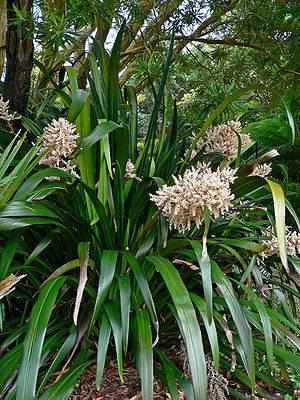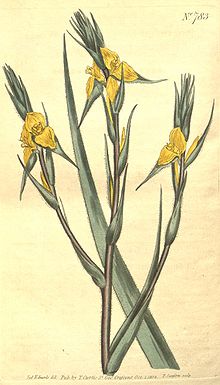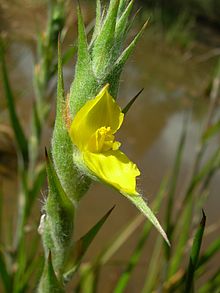Philydraceae
| Philydraceae | ||||||||||||
|---|---|---|---|---|---|---|---|---|---|---|---|---|

|
||||||||||||
| Systematics | ||||||||||||
|
||||||||||||
| Scientific name | ||||||||||||
| Philydraceae | ||||||||||||
| link |
The Philydraceae are a family in the order of the Commelina-like (Commelinales) within the flowering plants (Magnoliopsida). This small family contains three to four genera with only five to six species.
description


Appearance and leaves
The species of Philydraceae are perennial herbaceous plants . They mostly form underground storage organs: tubers or short rhizomes . They are often found in swampy areas.
The leaves are usually arranged directly above the ground, i.e. basal, rosette-like or alternating in two rows or spirals on the stem . The simple leaf blade is parallel-veined, mostly isobifacial to ensiform and with entire margins. Some taxa have xeromorphic leaves. The stomata are paracytic.
Inflorescences and flowers
The sessile flowers are usually formed in simple or branched, woolly hairy, spiked inflorescences . The bracts are relatively noticeable.
The hermaphrodite flowers are threefold and strongly zygomorphic . Some species have a strong odor. There are two circles per flower, each with three bracts , which are designed very differently, the outer ones being considerably larger than the inner ones, some are fused together; they are white or yellow. There is only one stamen per flower . Three carpels are a top permanent ovary fused with 15 to 50 per ovule per ovary chamber. The style ends in a large, cephalic or three-lobed scar.
Fruits and seeds
Three-lobed capsule fruits with many seeds are formed. The seeds contain plenty of starchy endosperm .
Ingredients and sets of chromosomes
Pro- anthocyanidins : cyanidin and delphinidin should be mentioned as ingredients . There are calcium oxalate crystals embedded as raphides.
The chromosome sets are n = 8, 16, 17.
Systematics and distribution
Taxa of this family thrive from the tropics to the subtropics of Southeast Asia via the Malay Archipelago to Japan and Australia . The main distribution area is Australia. They usually thrive in swamps or along bodies of water, always in locations with constantly moist soils .
The family name Philydraceae was first published in 1821 by Heinrich Friedrich Link in Enumeratio Plantarum Horti Regii Berolinensis Altera , 1, p. 5. The type genus is Philydrum Banks ex Gaertn.
The Philydraceae are most closely related to the Haemodoraceae and Pontederiaceae within the order of the Commelinales .
The Philydraceae family contains three to four genera with a total of five to six species:
-
Helmholtzia F. Muell. (Syn .: Orthothylax (Hook. F.) Skottsb. , Philydrum sect. Helmholtzia (F.Muell.) Baill. ): The three species are common in the Australian states of New South Wales and Queensland and from Maluku to New Guinea :
- Helmholtzia acorifolia F. Muell. : It occurs only in northeast Queensland.
- Helmholtzia glaberrima (Hook. F.) Caruel (Syn .: Orthothylax glaberrimus (Hook. F.) Skottsb. , Philydrum glaberrimum Hook. F. ): It occurs only on Mt. Warning in eastern Australia in New South Wales and Queensland.
- Helmholtzia novoguineensis (K. Krause) Skottsb. : It occurs from Maluku to New Guinea.
-
Philydrella Caruel (Syn .: Hetaeria Endl. , Philydrum sect. Pritzelia Baill. , Pritzelia F.Muell. Nom. Illeg.): It contains only two species in southwestern Australia:
- Philydrella drummondii L.G.Adams : It is only found in the Australian state of Western Australia .
-
Philydrella pygmaea (R.Br.) Caruel (Syn .: Hetaeria pygmaea (R.Br.) Endl. Ex Kunth , Hetaeria pygmaea Endl. , Nom. Illeg., Philydrum pygmaeum R.Br. , Pritzelia pygmaea (R.Br. ) F.Muell. Ex Benth. Nom. Illeg.): It occurs with two subspecies in the Australian state of Western Australia:
- Philydrella pygmaea subsp. minima L.G.Adams
- Philydrella pygmaea (R.Br.) Caruel subsp. pygmaea
-
Philydrum Banks ex Gaertn. : It contains only one type:
- Philydrum lanuginosum Gaertn. : It iswidespreadfrom India , via Myanmar , Thailand , China and Vietnam to Japan and from Malaysia via Papua New Guinea to northern Australia (Western Australia, Northern Territory , Queensland, New South Wales , Victoria ).
More pictures
Habit with leaves and inflorescences
swell
- The family of philydraceae in APWebsite. (Sections systematics and description)
- The Philydraceae family at DELTA by L. Watson and MJDallwitz. (Section description)
- Guofang Wu, Kai Larsen: Philydraceae. , P. 43 - online with the same text as the printed work , In: Wu Zheng-yi, Peter H. Raven (Ed.): Flora of China. Volume 24: Flagellariaceae through Marantaceae , Science Press and Missouri Botanical Garden Press, Beijing and St. Louis, 2000, ISBN 0-915279-83-5 (sections description and distribution)
- The Philydraceae family in the Flora of Western Australia . (Section description)
- Philydraceae at Flora of Australia Online . (Section description)
Individual evidence
- ↑ Philydraceae at Tropicos.org. Missouri Botanical Garden, St. Louis, accessed November 11, 2014.
- ↑ Philydraceae in the Germplasm Resources Information Network (GRIN), USDA , ARS , National Genetic Resources Program. National Germplasm Resources Laboratory, Beltsville, Maryland.
- ↑ Rafaël Govaerts (ed.): Philydraceae. In: World Checklist of Selected Plant Families (WCSP) - The Board of Trustees of the Royal Botanic Gardens, Kew . Retrieved November 11, 2014.
- ↑ a b c d e f g data sheet - Philydraceae at Australian Plant Name Index = APNI.


